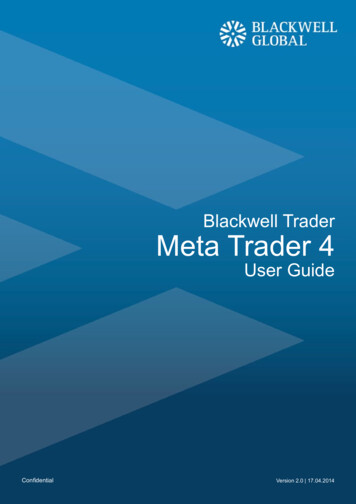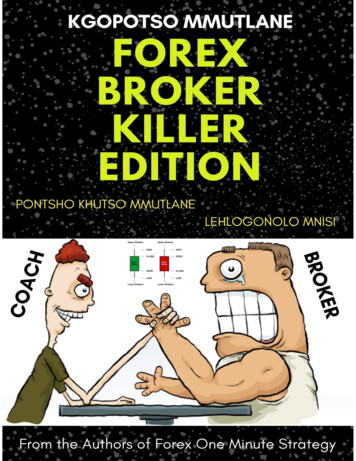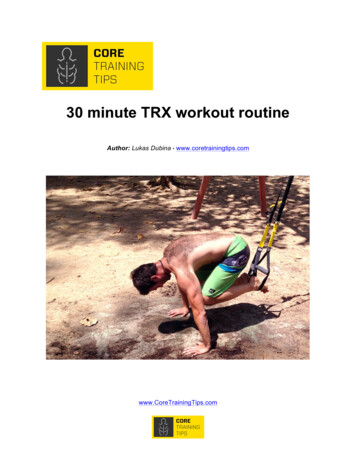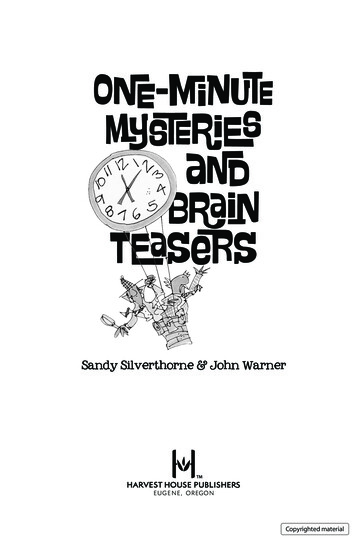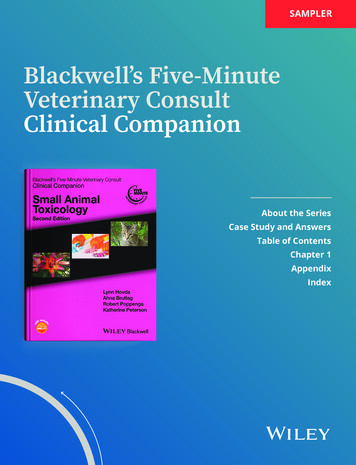
Transcription
SAMPLERBlackwell’s Five-MinuteVeterinary ConsultClinical CompanionAbout the SeriesCase Study and AnswersTable of ContentsChapter 1AppendixIndex
About the Series Features the familiar Five-MinuteVeterinary Consult framework Builds on sections of the speciesspecific consults, with more detailon each topic and additionaltopics included Carefully organized with bulletedinformation for quick search andeasy reference Full-color photographs Written by subject experts Companion website (or CD) with clienthandouts and/or case studies(select titles) Authoritative coverage of:oCanine and Feline BehavioroCanine and Feline InfectiousDiseases and ParasitologyoSmall Animal Emergency andCritical CareoSmall Animal DermatologyoSmall Animal ToxicologyoSmall Animal DentistryoSmall Animal Endocrinologyand ReproductionoEquine Theriogenology
Clinical Case Study (available on the companion website)Terrible turn in toxicologyYou are excited that your first senior rotation is two weeks at a regional animal poison control center. Thecenter provides public services as well as veterinarians professional guidance. You get to answer the phoneswith a supervising veterinary toxicologist.At 2 am during your first shift a small animal practice veterinarian calls about a 1-year-old rat terrier that shethinks has ingested some sort of toxin. She is driving into town as she calls so the information she relates isfrom her technician who has reached the clinic and has initiated lab work already.Apparently, two days ago the dog was accidentally trapped in the neighbor’s garage overnight and most of thenext day. The owners had been searching for him and when they finally located him in the garage he wasvomiting profusely and had diarrhea. They thought he must have gotten into something as he was perfectlyfine before that and the neighbor’s garage had every possible piece of junk, food, yard equipment and anassortment of chemicals for his vehicles, lawn, home, etc.The referring vet stated the dog’s initial lab showed a markedly elevated Ca and moderately elevated PO4.The technician was horrified that his Ca /PO4 ratio was exceptionally high! The dog reportedly lookeddehydrated but had isosthenuric urine. His BUN and creatinine were elevated and a CBC indicatedhemoconcentration and a mild stress leukogram. He was depressed and still vomiting when the techniciancalled you.You had just finished Toxicology 426 so you knew the three top differentials, the tests you would do toconfirm your diagnosis and how you would start treatment.1. Of the following, which would best characterize the toxicosis described and the top 3 differential diagnosesfor the “Terrible Turn in Toxicology”?Student ResponseValue1. Nephrotoxin ethylene glycol, aflatoxin,raisins2. Hepatotoxin cholecalciferol, ethylene glycol,aflatoxin3. Nephrotoxin cholecalciferol, ethylene glycol,raisins4. Nephrotoxin raisins, bromethalin, lilies5. Nephrotoxin arsenic, bromethalin, grapes1Correct AnswerFeedback
2. For the differential list you selected (Terrible Turn in Toxicology), which combination of tests would mostclearly support the correct diagnosis?Student ResponseValueCorrect AnswerFeedback1. azotemia, isosthenuria, leukocytosis2. azotemia, hypocalcemia, isosthenuria3. acidosis, hypocalcemia, hyperosmolality4. acidosis, hypercalcemia, hyposthenuria5. azotemia, hypercalcemia, isosthenuria6. azotemia, cholestasis, hyperbilirubinemia7. azotemia, hyperglycemia, isosthenuria3. Given the circumstances for our dog in this “Terrible Turn”, select a potential treatment regimen you wouldrecommend for a client with limited financial resources. You may choose 2 options.Student ResponseValue Correct FeedbackAnswer1. Activated charcoal initiallyand again at 12 hours; startIV saline, furosemide andcorticosteroid; monitorserum calcium, BUN andUA specific gravityThis is a good start because it monitors importantparameters, but it doesn’t have a contingency for using amore powerful drug to reduce calcium. Early therapymay forestall the need for D3 drug antidote.2. Emesis, cathartic, activatedcharcoal, IV fluids and starton salmon calcitonin q6hfor 4 days; monitor BUNand UA specific gravityPatient has already been vomiting, and adequatelaboratory evaluation has not been done.3. Activated charcoal initiallyand again at 12 hours; startIV saline, furosemide andcorticosteroid; monitorserum calcium, BUN andUA specific gravity; startsalmon calcitonin if serumCa 14 mg/dLThis choice provides excellent upfront detoxification(charcoal twice) and monitoring with a decision pointthat is specific (Ca @ 14 mg/dL); still allows client inputif the decision point comes.4. Activated charcoal initiallyand again at 12 hours; startThis choice provides excellent upfront detoxification(charcoal twice) and monitoring with a decision point2
IV saline, furosemide andcorticosteroid; monitorserum calcium, BUN andUA specific gravity; startpamidronate if serum Ca 14 mg/dL5. Start pamidronate and IVfluids, continue until UA isnormalthat is specific (Ca @ 14 mg/dL); still allows client todecide about pamidronate therapy if conditions worsen.Remember, the reduced number of doses may keepdown total drug use as well as reduce hospital care costs.Overkill without proper evaluation of patient status.4. If this case had terminated as a fatality without being submitted for antemortem veterinary care, which ofthe following could you use to confirm toxicosis in a cost-effective manner? SELECT 3.Student ResponseValueCorrect Answer Feedback1. Radiography of the renal area for increasedradiodensity of the kidneys related tocalcium contentOption if necropsy is notdesired2. Targeted necropsy of heart, GI tract andkidneys with submission for histopathologyexamAllows for confirmation ofdiagnosis by traditionalhistopathology3. Chemical analysis of kidney for the toxicmetaboliteMany labs don’t have thecapability to findmetabolites4. Chemical analysis of kidney for calciumcontentInexpensive and readilyavailable assay5. Chemical assay for primary toxicant in liverand metabolites in liver and kidneyExpensive and many labsdon’t offer both primarytoxicant and secondarymetabolites3
Clinical Case Study Answers (available on the companion website)Terrible turn in toxicologyYou are excited that your first senior rotation is two weeks at a regional animal poison control center. Thecenter provides public services as well as veterinarians professional guidance. You get to answer the phoneswith a supervising veterinary toxicologist.At 2 am during your first shift a small animal practice veterinarian calls about a 1-year-old rat terrier that shethinks has ingested some sort of toxin. She is driving into town as she calls so the information she relates isfrom her technician who has reached the clinic and has initiated lab work already.Apparently, two days ago the dog was accidentally trapped in the neighbor’s garage overnight and most of thenext day. The owners had been searching for him and when they finally located him in the garage he wasvomiting profusely and had diarrhea. They thought he must have gotten into something as he was perfectlyfine before that and the neighbor’s garage had every possible piece of junk, food, yard equipment and anassortment of chemicals for his vehicles, lawn, home, etc.The referring vet stated the dog’s initial lab showed a markedly elevated Ca and moderately elevated PO4.The technician was horrified that his Ca /PO4 ratio was exceptionally high! The dog reportedly lookeddehydrated but had isosthenuric urine. His BUN and creatinine were elevated and a CBC indicatedhemoconcentration and a mild stress leukogram. He was depressed and still vomiting when the techniciancalled you.You had just finished Toxicology 426 so you knew the three top differentials, the tests you would do toconfirm your diagnosis and how you would start treatment.1. Of the following, which would best characterize the toxicosis described and the top 3 differential diagnosesfor the “Terrible Turn in Toxicology”?Student ResponseValue1. Nephrotoxin ethylene glycol, aflatoxin,raisins2. Hepatotoxin cholecalciferol, ethylene glycol,aflatoxin3. Nephrotoxin cholecalciferol, ethylene glycol, 100%raisins4. Nephrotoxin raisins, bromethalin, lilies5. Nephrotoxin arsenic, bromethalin, grapes1Correct AnswerFeedback
2. For the differential list you selected (Terrible Turn in Toxicology), which combination of tests would mostclearly support the correct diagnosis?Student ResponseValueCorrect AnswerFeedback1. azotemia, isosthenuria, leukocytosis2. azotemia, hypocalcemia, isosthenuria3. acidosis, hypocalcemia, hyperosmolality4. acidosis, hypercalcemia, hyposthenuria5. azotemia, hypercalcemia, isosthenuria100%6. azotemia, cholestasis, hyperbilirubinemia7. azotemia, hyperglycemia, isosthenuria3. Given the circumstances for our dog in this “Terrible Turn”, select a potential treatment regimen you wouldrecommend for a client with limited financial resources. You may choose 2 options.Student ResponseValue Correct FeedbackAnswer1. Activated charcoal initially 50%and again at 12 hours; startIV saline, furosemide andcorticosteroid; monitorserum calcium, BUN andUA specific gravityThis is a good start because it monitors importantparameters, but it doesn't have a contingency for using amore powerful drug to reduce calcium. Early therapymay forestall the need for D3 drug antidote.2. Emesis, cathartic, activatedcharcoal, IV fluids and starton salmon calcitonin q6hfor 4 days; monitor BUNand UA sp. gr.Patient has already been vomiting, and adequatelaboratory evaluation has not been done.3. Activated charcoal initially 50%and again at 12 hours; startIV saline, furosemide andcorticosteroid; monitorserum calcium, BUN andUA specific gravity; startsalmon calcitonin if serumCa 14 mg/dLThis choice provides excellent upfront detoxification(charcoal twice) and monitoring with a decision pointthat is specific (Ca @ 14 mg/dL); still allows client inputif the decision point comes.4. Activated charcoal initially 50%and again at 12 hours; startThis choice provides excellent upfront detoxification(charcoal twice) and monitoring with a decision point2
IV saline, furosemide andcorticosteroid; monitorserum calcium, BUN andUA specific gravity; startpamidronate if serum Ca 14 mg/dL5. Start pamidronate and IVfluids, continue until UA isnormalthat is specific (Ca @ 14 mg/dL); still allows client todecide about pamidronate therapy if conditions worsen.Remember, the reduced number of doses may keepdown total drug use as well as reduce hospital carecosts.Overkill without proper evaluation of patient status.4. If this case had terminated as a fatality without being submitted for antemortem veterinary care, which ofthe following could you use to confirm toxicosis in a cost-effective manner? SELECT 3.Student ResponseValueCorrect Answer Feedback1. Radiography of the renal area for increased 33.333%radiodensity of the kidneys related tocalcium contentOption if necropsy is notdesired33.333%2. Targeted necropsy of heart, GI tract andkidneys with submission for histopathologyexamAllows for confirmation ofdiagnosis by traditionalhistopathology3. Chemical analysis of kidney for the toxicmetaboliteMany labs don’t have thecapability to findmetabolites4. Chemical analysis of kidney for calciumcontent33.333%Inexpensive and readilyavailable assayExpensive and many labsdon’t offer both primarytoxicant and secondarymetabolites5. Chemical assay for primary toxicant in liverand metabolites in liver and kidney3
ContentsContributor List . . . . . . . . . . . . . . . . . . . . . . . . . . . . . . . . . . . . . . . . . . . . . . . xiiiPreface . . . . . . . . . . . . . . . . . . . . . . . . . . . . . . . . . . . . . . . . . . . . . . . . . . . . . xixAbout the Companion Website . . . . . . . . . . . . . . . . . . . . . . . . . . . . . . . . . . . xxisection 1chapter 1chapter 2chapter 3chapter 4chapter 5section 2Clinical ToxicologyDecontamination and Detoxification of the Poisoned Patient . . . . . . . . . . . . . . 3Emergency Management of the Poisoned Patient . . . . . . . . . . . . . . . . . . . . . 19Antidotes and Other Useful Drugs . . . . . . . . . . . . . . . . . . . . . . . . . . . . . . . . . 36Identification and Management of the Unknown Toxicant . . . . . . . . . . . . . . . 49Laboratory Diagnostics for Toxicology . . . . . . . . . . . . . . . . . . . . . . . . . . . . . . 60Specific Toxins & ToxicantsAlcohols and Glycol Ethers . . . . . . . . . . . . . . . . . . . . . . . . . . . . . . . . . . . . . . . . . . . . . . .chapter 6Alcohols . . . . . . . . . . . . . . . . . . . . . . . . . . . . . . . . . . . . . . . . . . . . . . . . . . . .chapter 7Ethylene Glycol and Diethylene Glycol . . . . . . . . . . . . . . . . . . . . . . . . . . . . . .chapter 8Propylene Glycol . . . . . . . . . . . . . . . . . . . . . . . . . . . . . . . . . . . . . . . . . . . . . .69717885Construction and Industrial Materials . . . . . . . . . . . . . . . . . . . . . . . . . . . . . . . . . . . . . . 93chapter 9Glues and Adhesives . . . . . . . . . . . . . . . . . . . . . . . . . . . . . . . . . . . . . . . . . . . 95chapter 10Hydrocarbons . . . . . . . . . . . . . . . . . . . . . . . . . . . . . . . . . . . . . . . . . . . . . . . 101chapter 11Hydrofluoric Acid . . . . . . . . . . . . . . . . . . . . . . . . . . . . . . . . . . . . . . . . . . . . 10
7. azotemia, hyperglycemia, isosthenuria 3. Given the circumstances for our dog in this “Terrible Turn”, select a potential treatment regimen you would recommend for a client with limited financial resources. You may choose 2 options. Student Response Value Correct Answer Feedback 1. Activated charcoal initially and again at 12 hours; start

